Strategic Business Management: Team Roles, Governance, and Actions
VerifiedAdded on 2023/06/10
|7
|1487
|482
Report
AI Summary
This report outlines the team roles and responsibilities within a strategic business management context, with a focus on the role of the team leader. It details the importance of meeting attendance, levels of contribution, decision-making processes, and governance. Actions to be taken by team members are specified, along with the expected standard of work. The report also addresses the mission and vision of the firm, the organizational hierarchy, and contingencies related to time management, workflow, and commitment to outcomes. It emphasizes the need for transparent and democratic decision-making, clear communication, and accountability within the team structure. Desklib provides access to similar solved assignments and study tools for students.
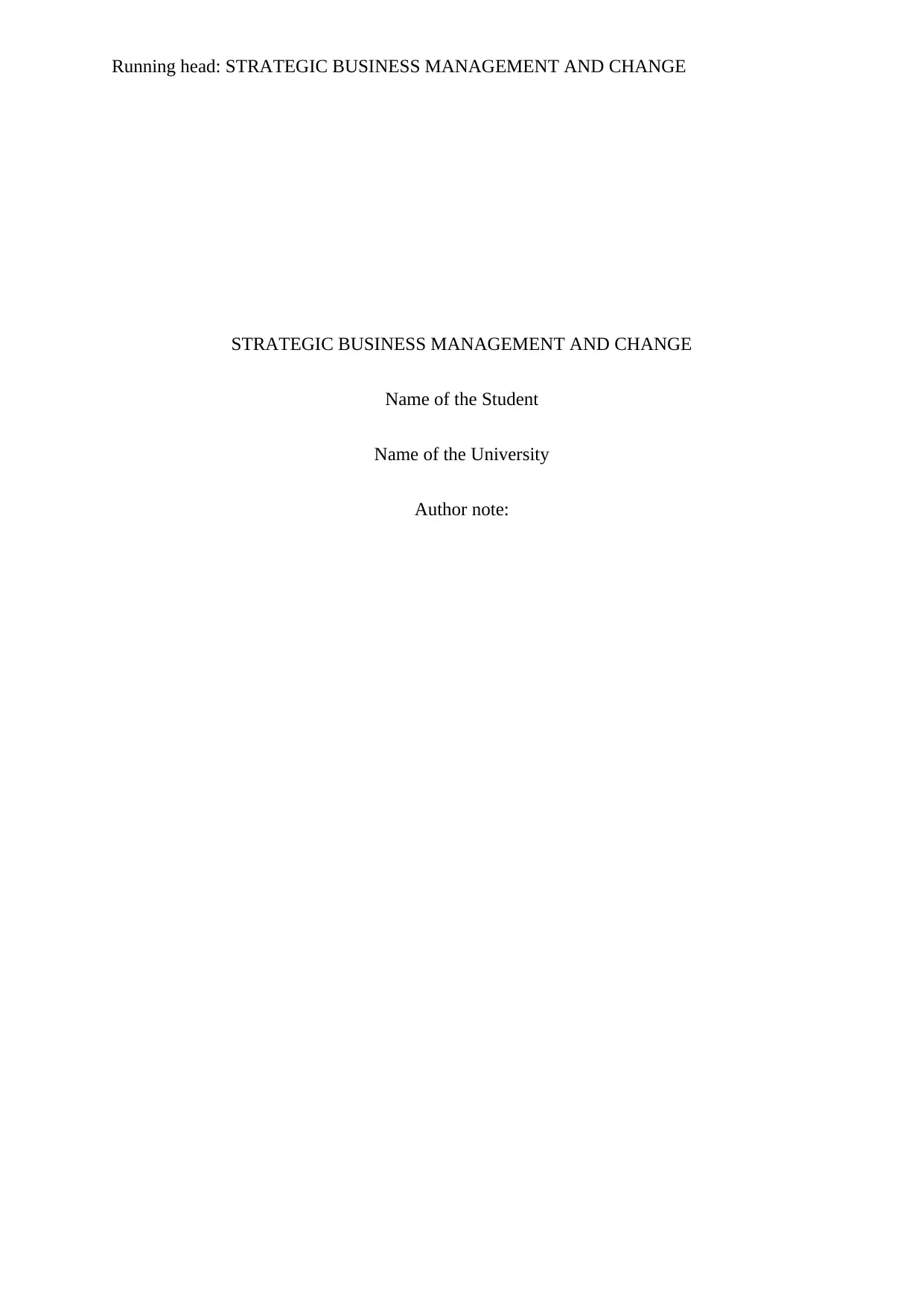
Running head: STRATEGIC BUSINESS MANAGEMENT AND CHANGE
STRATEGIC BUSINESS MANAGEMENT AND CHANGE
Name of the Student
Name of the University
Author note:
STRATEGIC BUSINESS MANAGEMENT AND CHANGE
Name of the Student
Name of the University
Author note:
Paraphrase This Document
Need a fresh take? Get an instant paraphrase of this document with our AI Paraphraser
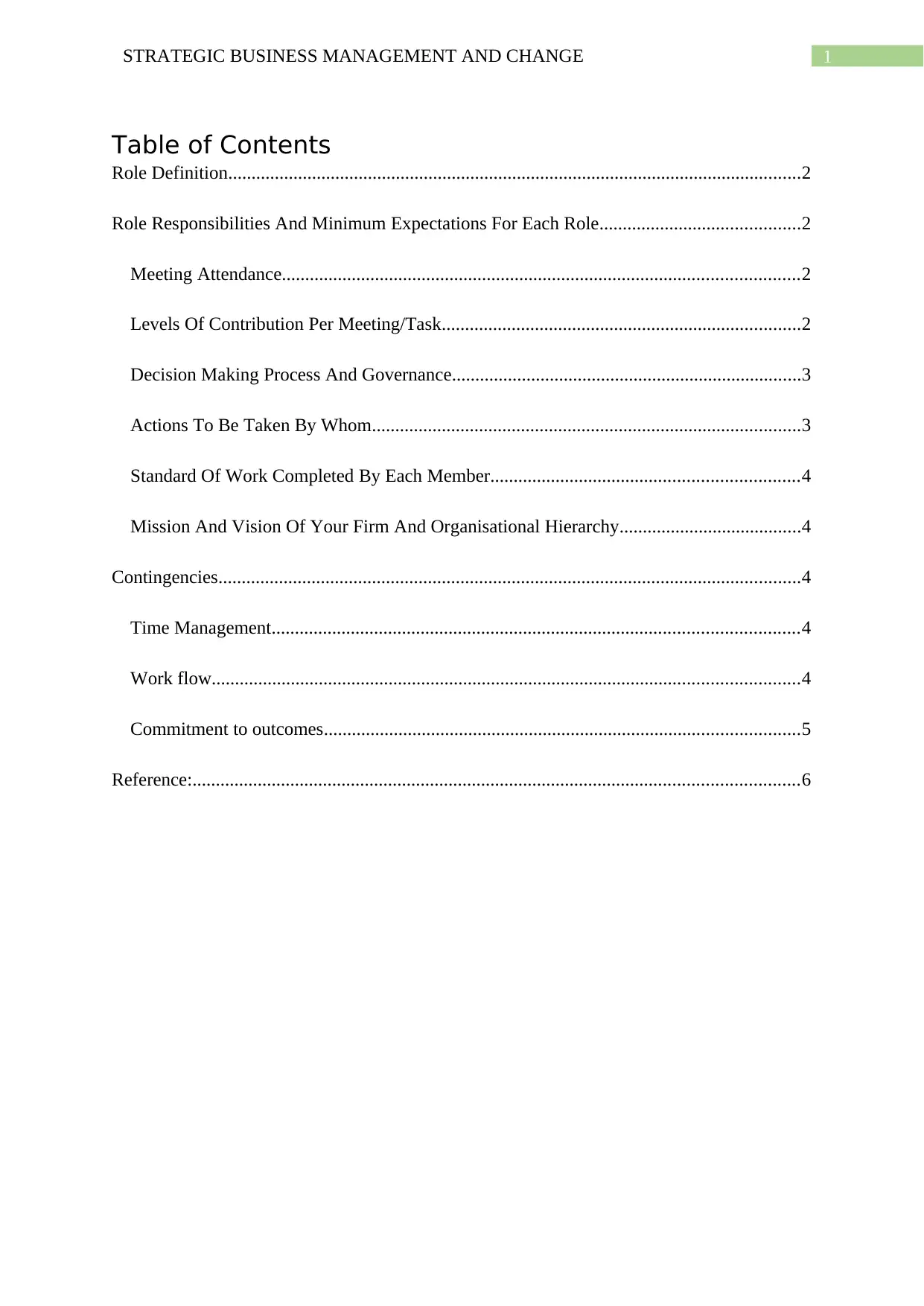
1STRATEGIC BUSINESS MANAGEMENT AND CHANGE
Table of Contents
Role Definition...........................................................................................................................2
Role Responsibilities And Minimum Expectations For Each Role...........................................2
Meeting Attendance...............................................................................................................2
Levels Of Contribution Per Meeting/Task.............................................................................2
Decision Making Process And Governance...........................................................................3
Actions To Be Taken By Whom............................................................................................3
Standard Of Work Completed By Each Member..................................................................4
Mission And Vision Of Your Firm And Organisational Hierarchy.......................................4
Contingencies.............................................................................................................................4
Time Management.................................................................................................................4
Work flow..............................................................................................................................4
Commitment to outcomes......................................................................................................5
Reference:..................................................................................................................................6
Table of Contents
Role Definition...........................................................................................................................2
Role Responsibilities And Minimum Expectations For Each Role...........................................2
Meeting Attendance...............................................................................................................2
Levels Of Contribution Per Meeting/Task.............................................................................2
Decision Making Process And Governance...........................................................................3
Actions To Be Taken By Whom............................................................................................3
Standard Of Work Completed By Each Member..................................................................4
Mission And Vision Of Your Firm And Organisational Hierarchy.......................................4
Contingencies.............................................................................................................................4
Time Management.................................................................................................................4
Work flow..............................................................................................................................4
Commitment to outcomes......................................................................................................5
Reference:..................................................................................................................................6
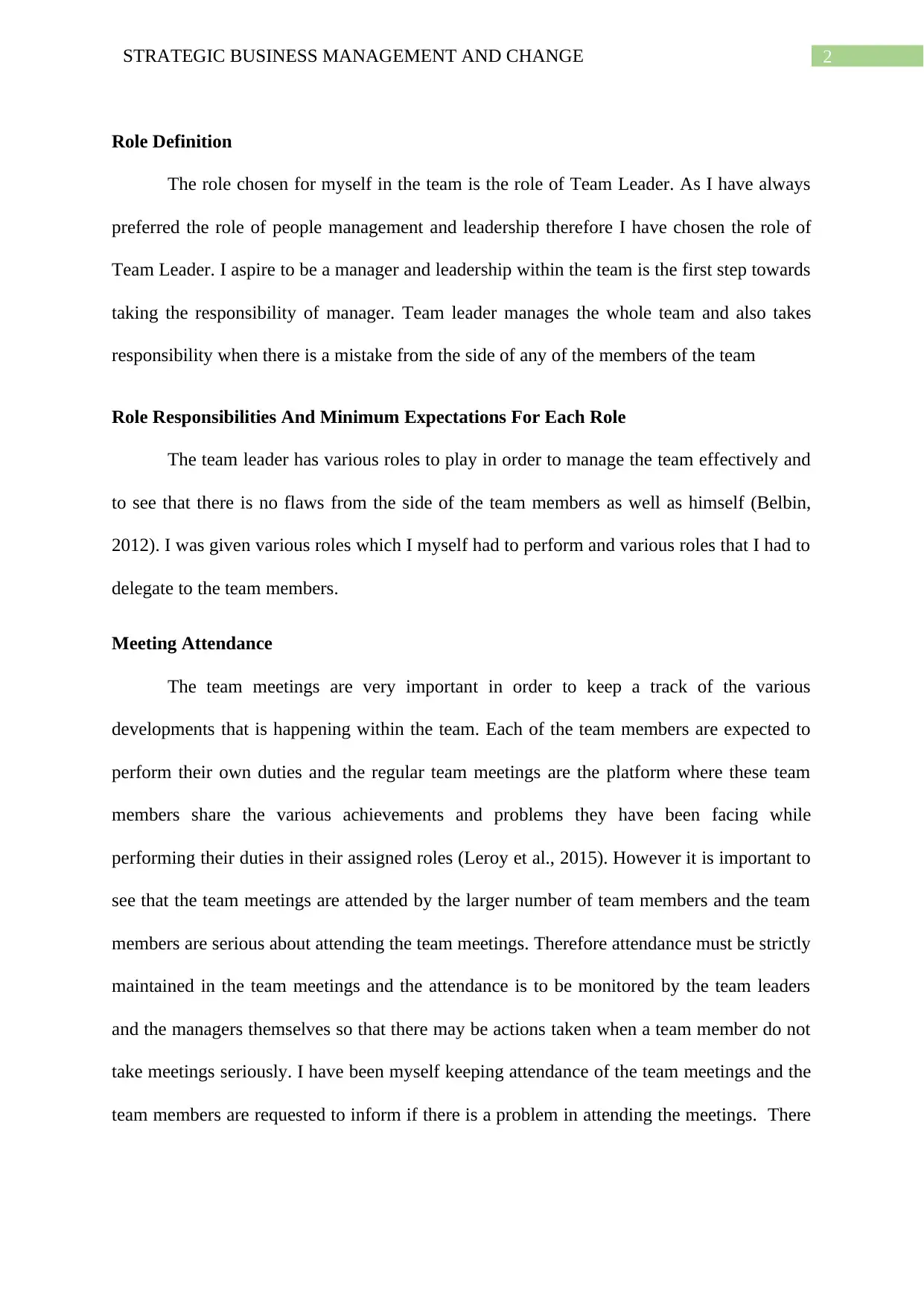
2STRATEGIC BUSINESS MANAGEMENT AND CHANGE
Role Definition
The role chosen for myself in the team is the role of Team Leader. As I have always
preferred the role of people management and leadership therefore I have chosen the role of
Team Leader. I aspire to be a manager and leadership within the team is the first step towards
taking the responsibility of manager. Team leader manages the whole team and also takes
responsibility when there is a mistake from the side of any of the members of the team
Role Responsibilities And Minimum Expectations For Each Role
The team leader has various roles to play in order to manage the team effectively and
to see that there is no flaws from the side of the team members as well as himself (Belbin,
2012). I was given various roles which I myself had to perform and various roles that I had to
delegate to the team members.
Meeting Attendance
The team meetings are very important in order to keep a track of the various
developments that is happening within the team. Each of the team members are expected to
perform their own duties and the regular team meetings are the platform where these team
members share the various achievements and problems they have been facing while
performing their duties in their assigned roles (Leroy et al., 2015). However it is important to
see that the team meetings are attended by the larger number of team members and the team
members are serious about attending the team meetings. Therefore attendance must be strictly
maintained in the team meetings and the attendance is to be monitored by the team leaders
and the managers themselves so that there may be actions taken when a team member do not
take meetings seriously. I have been myself keeping attendance of the team meetings and the
team members are requested to inform if there is a problem in attending the meetings. There
Role Definition
The role chosen for myself in the team is the role of Team Leader. As I have always
preferred the role of people management and leadership therefore I have chosen the role of
Team Leader. I aspire to be a manager and leadership within the team is the first step towards
taking the responsibility of manager. Team leader manages the whole team and also takes
responsibility when there is a mistake from the side of any of the members of the team
Role Responsibilities And Minimum Expectations For Each Role
The team leader has various roles to play in order to manage the team effectively and
to see that there is no flaws from the side of the team members as well as himself (Belbin,
2012). I was given various roles which I myself had to perform and various roles that I had to
delegate to the team members.
Meeting Attendance
The team meetings are very important in order to keep a track of the various
developments that is happening within the team. Each of the team members are expected to
perform their own duties and the regular team meetings are the platform where these team
members share the various achievements and problems they have been facing while
performing their duties in their assigned roles (Leroy et al., 2015). However it is important to
see that the team meetings are attended by the larger number of team members and the team
members are serious about attending the team meetings. Therefore attendance must be strictly
maintained in the team meetings and the attendance is to be monitored by the team leaders
and the managers themselves so that there may be actions taken when a team member do not
take meetings seriously. I have been myself keeping attendance of the team meetings and the
team members are requested to inform if there is a problem in attending the meetings. There
⊘ This is a preview!⊘
Do you want full access?
Subscribe today to unlock all pages.

Trusted by 1+ million students worldwide
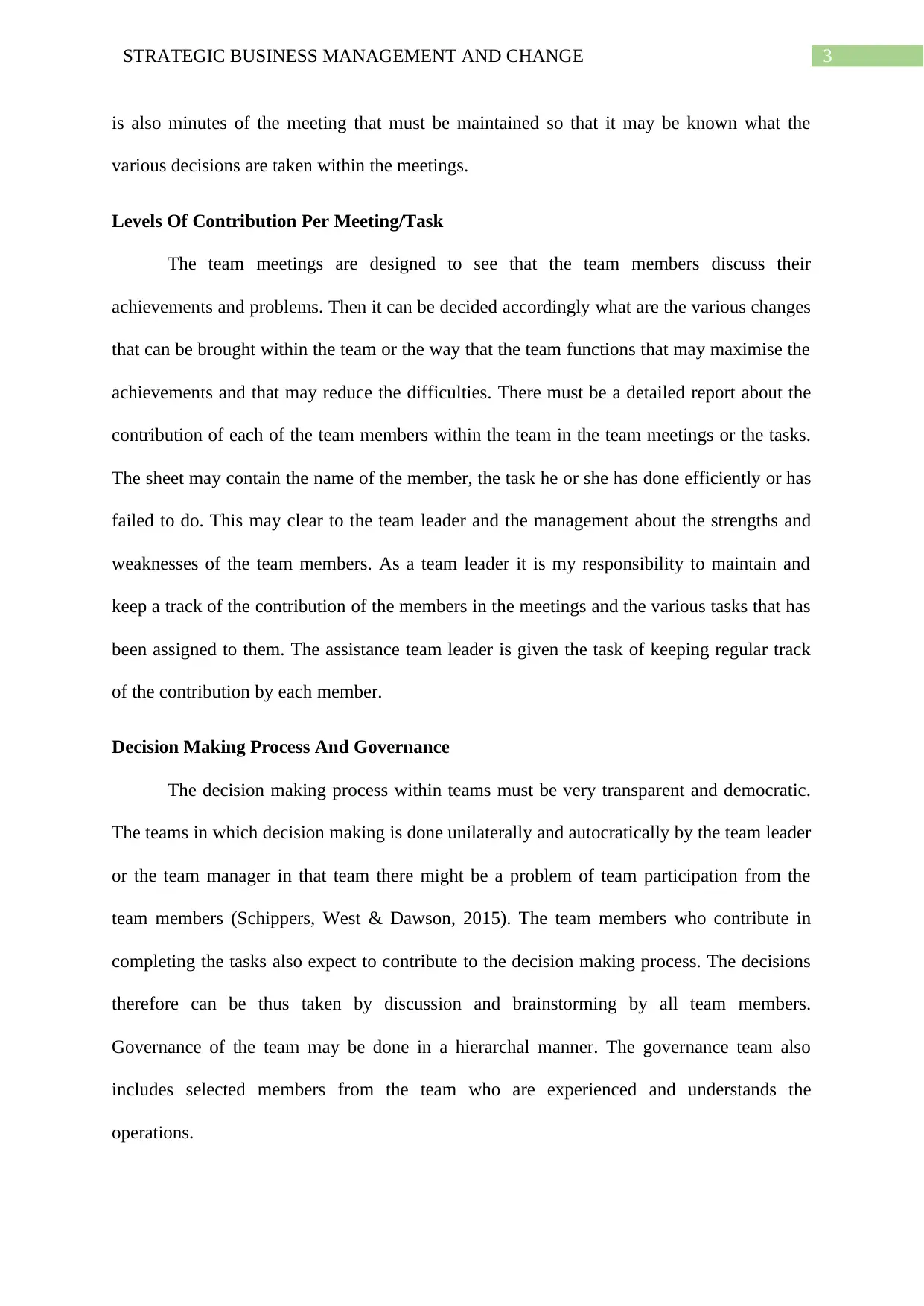
3STRATEGIC BUSINESS MANAGEMENT AND CHANGE
is also minutes of the meeting that must be maintained so that it may be known what the
various decisions are taken within the meetings.
Levels Of Contribution Per Meeting/Task
The team meetings are designed to see that the team members discuss their
achievements and problems. Then it can be decided accordingly what are the various changes
that can be brought within the team or the way that the team functions that may maximise the
achievements and that may reduce the difficulties. There must be a detailed report about the
contribution of each of the team members within the team in the team meetings or the tasks.
The sheet may contain the name of the member, the task he or she has done efficiently or has
failed to do. This may clear to the team leader and the management about the strengths and
weaknesses of the team members. As a team leader it is my responsibility to maintain and
keep a track of the contribution of the members in the meetings and the various tasks that has
been assigned to them. The assistance team leader is given the task of keeping regular track
of the contribution by each member.
Decision Making Process And Governance
The decision making process within teams must be very transparent and democratic.
The teams in which decision making is done unilaterally and autocratically by the team leader
or the team manager in that team there might be a problem of team participation from the
team members (Schippers, West & Dawson, 2015). The team members who contribute in
completing the tasks also expect to contribute to the decision making process. The decisions
therefore can be thus taken by discussion and brainstorming by all team members.
Governance of the team may be done in a hierarchal manner. The governance team also
includes selected members from the team who are experienced and understands the
operations.
is also minutes of the meeting that must be maintained so that it may be known what the
various decisions are taken within the meetings.
Levels Of Contribution Per Meeting/Task
The team meetings are designed to see that the team members discuss their
achievements and problems. Then it can be decided accordingly what are the various changes
that can be brought within the team or the way that the team functions that may maximise the
achievements and that may reduce the difficulties. There must be a detailed report about the
contribution of each of the team members within the team in the team meetings or the tasks.
The sheet may contain the name of the member, the task he or she has done efficiently or has
failed to do. This may clear to the team leader and the management about the strengths and
weaknesses of the team members. As a team leader it is my responsibility to maintain and
keep a track of the contribution of the members in the meetings and the various tasks that has
been assigned to them. The assistance team leader is given the task of keeping regular track
of the contribution by each member.
Decision Making Process And Governance
The decision making process within teams must be very transparent and democratic.
The teams in which decision making is done unilaterally and autocratically by the team leader
or the team manager in that team there might be a problem of team participation from the
team members (Schippers, West & Dawson, 2015). The team members who contribute in
completing the tasks also expect to contribute to the decision making process. The decisions
therefore can be thus taken by discussion and brainstorming by all team members.
Governance of the team may be done in a hierarchal manner. The governance team also
includes selected members from the team who are experienced and understands the
operations.
Paraphrase This Document
Need a fresh take? Get an instant paraphrase of this document with our AI Paraphraser
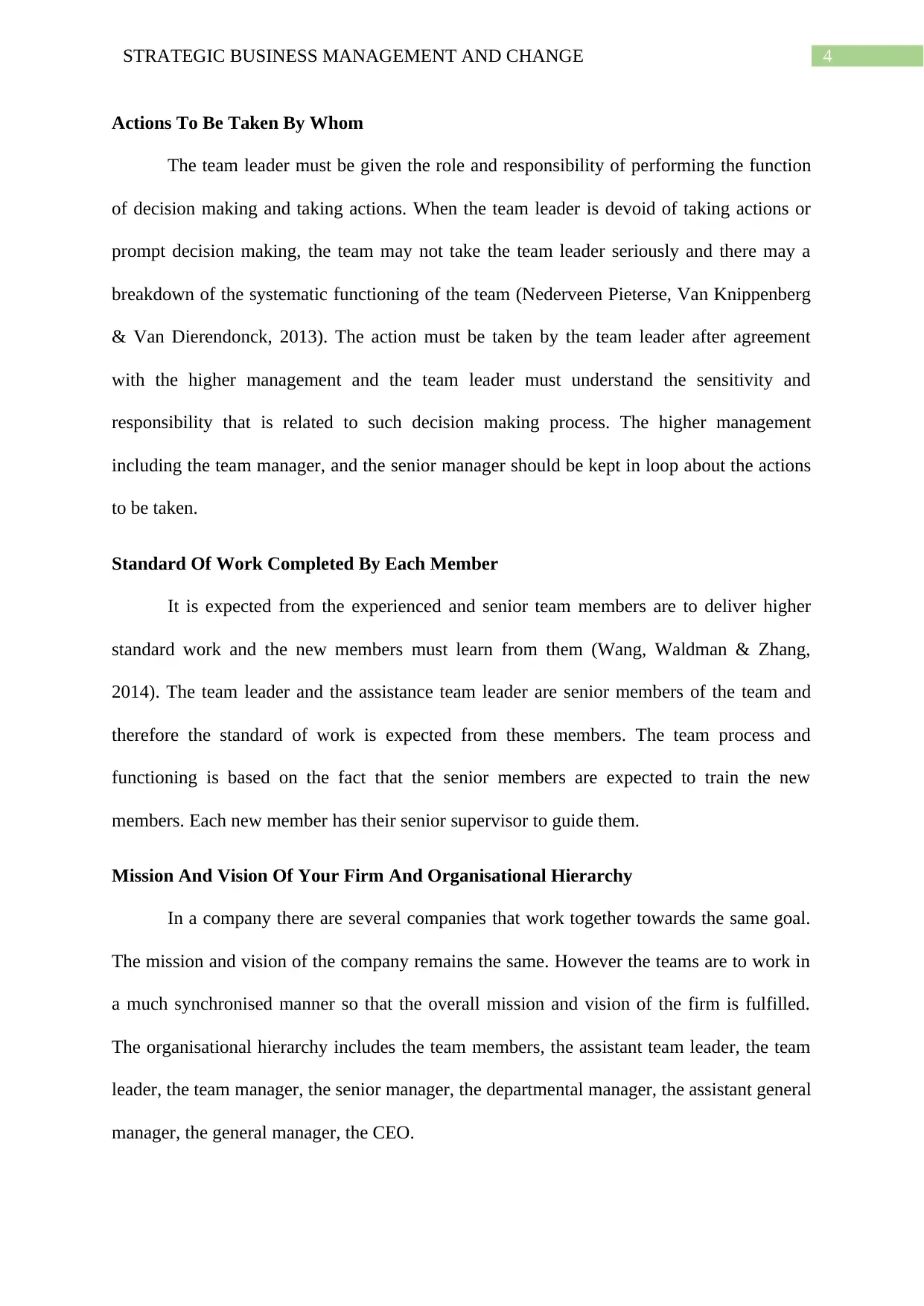
4STRATEGIC BUSINESS MANAGEMENT AND CHANGE
Actions To Be Taken By Whom
The team leader must be given the role and responsibility of performing the function
of decision making and taking actions. When the team leader is devoid of taking actions or
prompt decision making, the team may not take the team leader seriously and there may a
breakdown of the systematic functioning of the team (Nederveen Pieterse, Van Knippenberg
& Van Dierendonck, 2013). The action must be taken by the team leader after agreement
with the higher management and the team leader must understand the sensitivity and
responsibility that is related to such decision making process. The higher management
including the team manager, and the senior manager should be kept in loop about the actions
to be taken.
Standard Of Work Completed By Each Member
It is expected from the experienced and senior team members are to deliver higher
standard work and the new members must learn from them (Wang, Waldman & Zhang,
2014). The team leader and the assistance team leader are senior members of the team and
therefore the standard of work is expected from these members. The team process and
functioning is based on the fact that the senior members are expected to train the new
members. Each new member has their senior supervisor to guide them.
Mission And Vision Of Your Firm And Organisational Hierarchy
In a company there are several companies that work together towards the same goal.
The mission and vision of the company remains the same. However the teams are to work in
a much synchronised manner so that the overall mission and vision of the firm is fulfilled.
The organisational hierarchy includes the team members, the assistant team leader, the team
leader, the team manager, the senior manager, the departmental manager, the assistant general
manager, the general manager, the CEO.
Actions To Be Taken By Whom
The team leader must be given the role and responsibility of performing the function
of decision making and taking actions. When the team leader is devoid of taking actions or
prompt decision making, the team may not take the team leader seriously and there may a
breakdown of the systematic functioning of the team (Nederveen Pieterse, Van Knippenberg
& Van Dierendonck, 2013). The action must be taken by the team leader after agreement
with the higher management and the team leader must understand the sensitivity and
responsibility that is related to such decision making process. The higher management
including the team manager, and the senior manager should be kept in loop about the actions
to be taken.
Standard Of Work Completed By Each Member
It is expected from the experienced and senior team members are to deliver higher
standard work and the new members must learn from them (Wang, Waldman & Zhang,
2014). The team leader and the assistance team leader are senior members of the team and
therefore the standard of work is expected from these members. The team process and
functioning is based on the fact that the senior members are expected to train the new
members. Each new member has their senior supervisor to guide them.
Mission And Vision Of Your Firm And Organisational Hierarchy
In a company there are several companies that work together towards the same goal.
The mission and vision of the company remains the same. However the teams are to work in
a much synchronised manner so that the overall mission and vision of the firm is fulfilled.
The organisational hierarchy includes the team members, the assistant team leader, the team
leader, the team manager, the senior manager, the departmental manager, the assistant general
manager, the general manager, the CEO.
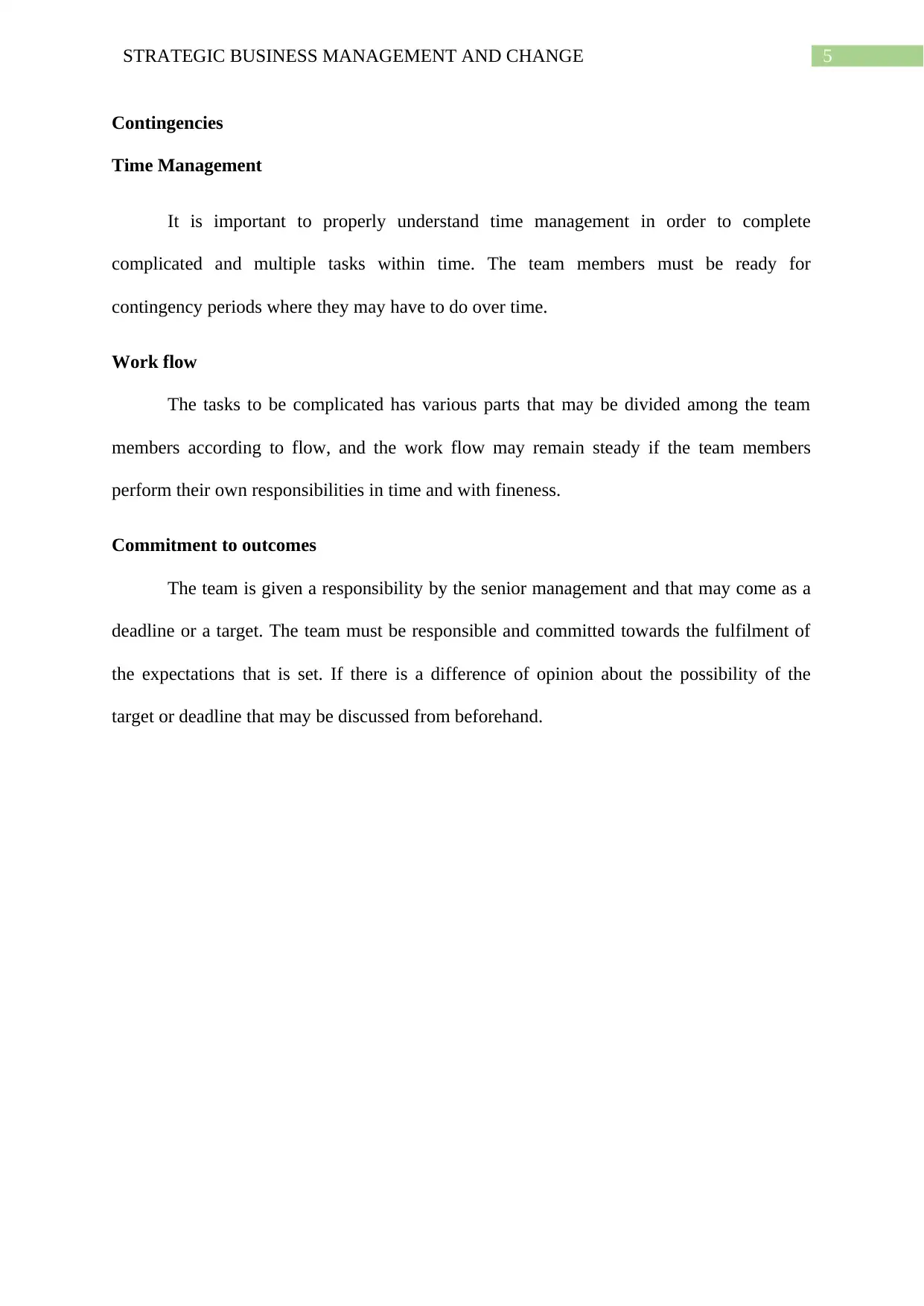
5STRATEGIC BUSINESS MANAGEMENT AND CHANGE
Contingencies
Time Management
It is important to properly understand time management in order to complete
complicated and multiple tasks within time. The team members must be ready for
contingency periods where they may have to do over time.
Work flow
The tasks to be complicated has various parts that may be divided among the team
members according to flow, and the work flow may remain steady if the team members
perform their own responsibilities in time and with fineness.
Commitment to outcomes
The team is given a responsibility by the senior management and that may come as a
deadline or a target. The team must be responsible and committed towards the fulfilment of
the expectations that is set. If there is a difference of opinion about the possibility of the
target or deadline that may be discussed from beforehand.
Contingencies
Time Management
It is important to properly understand time management in order to complete
complicated and multiple tasks within time. The team members must be ready for
contingency periods where they may have to do over time.
Work flow
The tasks to be complicated has various parts that may be divided among the team
members according to flow, and the work flow may remain steady if the team members
perform their own responsibilities in time and with fineness.
Commitment to outcomes
The team is given a responsibility by the senior management and that may come as a
deadline or a target. The team must be responsible and committed towards the fulfilment of
the expectations that is set. If there is a difference of opinion about the possibility of the
target or deadline that may be discussed from beforehand.
⊘ This is a preview!⊘
Do you want full access?
Subscribe today to unlock all pages.

Trusted by 1+ million students worldwide
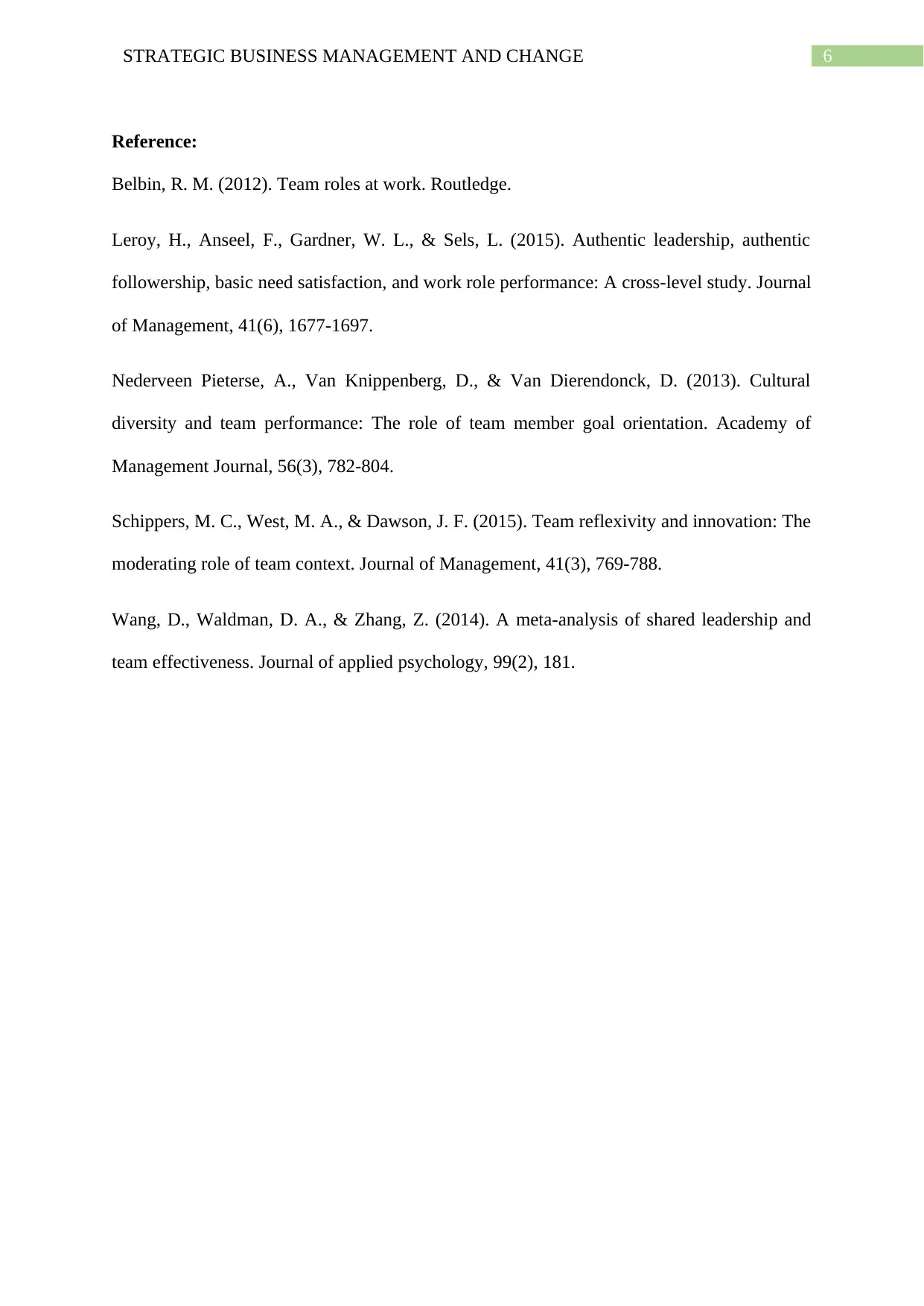
6STRATEGIC BUSINESS MANAGEMENT AND CHANGE
Reference:
Belbin, R. M. (2012). Team roles at work. Routledge.
Leroy, H., Anseel, F., Gardner, W. L., & Sels, L. (2015). Authentic leadership, authentic
followership, basic need satisfaction, and work role performance: A cross-level study. Journal
of Management, 41(6), 1677-1697.
Nederveen Pieterse, A., Van Knippenberg, D., & Van Dierendonck, D. (2013). Cultural
diversity and team performance: The role of team member goal orientation. Academy of
Management Journal, 56(3), 782-804.
Schippers, M. C., West, M. A., & Dawson, J. F. (2015). Team reflexivity and innovation: The
moderating role of team context. Journal of Management, 41(3), 769-788.
Wang, D., Waldman, D. A., & Zhang, Z. (2014). A meta-analysis of shared leadership and
team effectiveness. Journal of applied psychology, 99(2), 181.
Reference:
Belbin, R. M. (2012). Team roles at work. Routledge.
Leroy, H., Anseel, F., Gardner, W. L., & Sels, L. (2015). Authentic leadership, authentic
followership, basic need satisfaction, and work role performance: A cross-level study. Journal
of Management, 41(6), 1677-1697.
Nederveen Pieterse, A., Van Knippenberg, D., & Van Dierendonck, D. (2013). Cultural
diversity and team performance: The role of team member goal orientation. Academy of
Management Journal, 56(3), 782-804.
Schippers, M. C., West, M. A., & Dawson, J. F. (2015). Team reflexivity and innovation: The
moderating role of team context. Journal of Management, 41(3), 769-788.
Wang, D., Waldman, D. A., & Zhang, Z. (2014). A meta-analysis of shared leadership and
team effectiveness. Journal of applied psychology, 99(2), 181.
1 out of 7
Related Documents
Your All-in-One AI-Powered Toolkit for Academic Success.
+13062052269
info@desklib.com
Available 24*7 on WhatsApp / Email
![[object Object]](/_next/static/media/star-bottom.7253800d.svg)
Unlock your academic potential
Copyright © 2020–2025 A2Z Services. All Rights Reserved. Developed and managed by ZUCOL.





